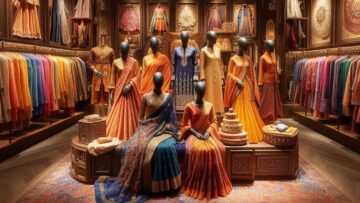 The growing customer consciousness due to the increasing number of tragedies in cheap Asian garment producing countries coupled with rising labour costs, poor quality of garments, longer lead times, besides the growing patriotic wave to generate more employment in the country in the wake of economic crisis is resulting in many American brands and retailers to bring production back to its home shore, however with underlying problems of its own.
The growing customer consciousness due to the increasing number of tragedies in cheap Asian garment producing countries coupled with rising labour costs, poor quality of garments, longer lead times, besides the growing patriotic wave to generate more employment in the country in the wake of economic crisis is resulting in many American brands and retailers to bring production back to its home shore, however with underlying problems of its own.
In the past few years, apparel manufacturing which left the US in mass exodus more than two decades ago is slowly getting back into creating job opportunities for the people. According to the US Jobs Report for the month of June 2013, a total of 1,95,000 jobs have been reported in this segment, raising hope that the ‘Made in US’ trend will grow. Industry watchers agree that this shift does not mean that the country will regain its lost 19 million manufacturing workers that formed the backbone of the industry in the 1980s, but the upward movement in US domestic manufacturing after decades of downturn could boost the economy and encourage innovative strategies.
[bleft]Made in America Act introduced in the US
Aims at encouraging consumers to buy ‘Made in America’ products
Incentives for manufacturers to increase domestic production
Voluntary labelling service helping consumers to identify American-made products
The Secretary of Commerce to setup the standards
Need additional inputs from the Federal Trade Commission to ensure consistency[/bleft]
The move by designers, retailers and a number of smaller companies to move some part of their production back to the US has also been prompted by the fact that consumers are more aware about the labels that they wear and the industry is under constant pressure to cut down the duration between designing the product and getting it on store shelves. Brooks Brothers, a major retailer of menswear have moved 70 per cent of their suit production to a plant in Haverhill, Massachusetts, mostly from foreign locations and is also bringing back production of some dress shirts, overcoats and pants back to the country. “There are opportunities to test products made in America,” says Claudio Del Vecchio, Chief Executive, Brooks Brothers, adding that the percentage of the apparel retailer’s made in US stock as part of the total, has increased substantially. “It’s part of our culture to support American manufacturing. We like to buy from America,” admits Vecchio.
The most important commitment to bring back manufacturing to the US was announced by Walmart, a pioneer of global sourcing of cheap goods, that has pledged to spend around US $ 50 billion with American suppliers over the next decade. “At the heart of our national political conversation today is one issue: creating jobs to grow the economy. We are meeting with our suppliers on domestic manufacturing and are making a strong commitment to move this forward,” informs Bill Simon, President and CEO, Walmart USA. As the US economy evolves out of the economic downturn, consumers are differentiating between cheap overseas goods and disappearing US jobs.
[bleft]Apart from the consumers changing attitude, increasing labour costs in markets such as China, higher import duties, coupled with the fluctuating currency exchange rates, deteriorating quality of apparels and uncertainty over fuel costs, is also making manufacturing in the US more attractive for high street retailers.[/bleft]
Earlier this year, Nicholas P. Brayton, President, Woolrich pledged to revive Pennsylvania’s dormant garment industry by increasing the 183-year-old company’s American-made offerings. Although Woolrich operates the country’s oldest continually running textile mill, Brayton admits that it’s made the “same difficult choice” to outsource production in order to remain competitive. “In today’s world, the hard reality is that making things here is hard to do,” he wrote. “But like our customers who embrace adventure every day, Woolrich is preparing to tackle a new challenge… bringing manufacturing back to Pennsylvania, one step at a time,” said Brayton. The fall collection for 2013/14 from the retailer is committed to be 100 per cent made in the USA.
As the factories in Asia are rapidly increasing their wages, bridging the gap between the low-cost producing countries, the US has been witnessing a rise in factory output, strong manufacturing production gains and low labour costs, which is making the American workers more attractive to the retailers and brands. In the wake of the worst garment accident in the history of apparel sourcing – the collapse of a factory in Bangladesh, which took the lives of more than 1000 people – the limelight falls back on the human cost of producing cheap goods through global supply chain. Also, the bargains on store shelves in the US is a constant reminder to consumers, that it comes at the expense of worker’s safety in cheap producing garment nations.
Increasingly, production is getting shifted to Mexico and Central America’s Northern Triangle (Guatemala, Honduras, and El Salvador). Around 17 per cent of the workforce in these four countries is employed in manufacturing, and immigrants from these countries make up 8 per cent of the US manufacturing workforce.
Amongst them, Mexico which has a huge advantage of bordering the United States is increasingly attracting production intended for the Americas that would have previously gone to China. Today, the average pay for a Mexican worker is only slightly higher than its Chinese counterpart, but poor infrastructure and drugs-related crime mar this production hub, which could deter many retailers to enter production. According to the Boston Consulting Group, a major business strategy consultancy, average factory wages in China this year is around US $ 4.50 an hour, including benefits and other costs, and is likely to reach US $ 6 an hour by 2015. However, the National Statistics Institute of Mexico confirms that the average manufacturing wages in June was US $ 3.50, excluding benefits. However, it is yet to be seen whether Mexico can leverage its low-wage status into rapid sustainable growth for which it needs policies to promote small and medium businesses and accelerate higher-end production, and to draw its workers towards economic growth.
Meanwhile, Mexico can be seen as an alternative to manufacturing in China in purview of its proximity towards the US, as retailers are constantly looking at providing quick change in fashion to their customers. According to Steva Sadove, Chief Executive Officer, Saks Inc. (SKS), “We are seeing resurgence in ‘Made in America’ in contemporary brands and are increasing sourcing because you can get replenishment much more easily through a supply chain in America.” Though the labour costs will be expensive in the US in comparison to any other Asian country but the US has an advantage in various other areas in comparison to China that can be exploited.






